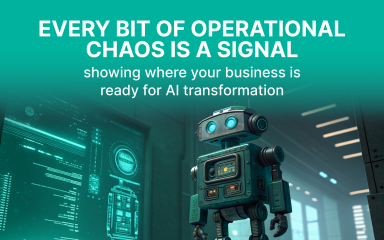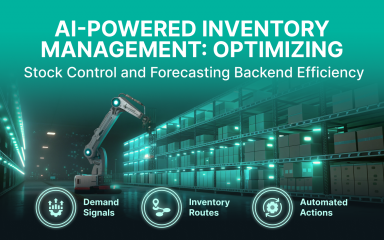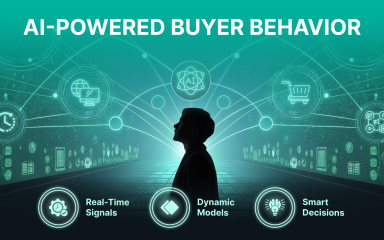Artificial intelligence (AI) is not only a disruptive force but the most vital competitive advantage in contemporary digital marketing. To an ecommerce marketer, product marketing manager, and CX strategist, AI is a clear way out of customer acquisition costs and creating a strong customer retention. AI digital marketing takes businesses beyond mere segmentation to hyper-personalize at scale and turns each customer touchpoint into an opportunity accurate and revenue-driving.
Why then are there brands that appear to be reading your mind before you utter the words? The solution is in predictive marketing- the science of forecasting customer needs with the help of AI.
This automated execution with this intelligence enables brands to implement highly efficient strategies such as predictive ads and advanced digital shelf analytics. Indeed, about 70% of the marketers have already incorporated AI in their operations and this is a direct indication that this technology is becoming a staple.
You’ll learn how AI enhances customer acquisition and retention strategies through recommendation engines, predictive advertising, real-time campaign optimization, and digital shelf insights. The article dissects the ultimate tools and strategies that you must have in order to gain on the virtual shelf and achieve quantifiable ecommerce expansion.
AI Digital Marketing Tools: The Modern Growth Stack
AI marketing tools are software platforms that utilize machine learning models to automate, optimize, and personalize marketing efforts across various channels. They automate activities such as targeting adverts, content generation, and data analysis thus allowing marketers to be quicker and smarter than it is with the manual system.
The modern growth stack relies on a core set of AI capabilities: recommendation engines, advanced AI targeting, and predictive analytics dashboards.
Recommendation Engines: Personalization at Scale
Recommendation engines are AI systems that suggest personalized product recommendations to a user based on their past behavior and the real-time actions of similar customers.
- Their functionality: These engines process large amounts of behavioral data (views, clicks, purchases) with the help of collaborative filtering and deep learning to extract patterns. The intelligent recommendation models can be implemented to increase conversions up to 20 percent by making sure that the product is presented to the right person at the right moment.
AI-Powered Targeting and Predictive Ads
AI has transformed the ad platforms beyond the rudimentary demographic filtering. AI targeting uses predictive analytics to model which potential customers are most likely to convert, even before they enter the traditional sales funnel.
- Predictive Ads: Tools like Albert integrate with platforms like Google Ads and Meta to automate budget allocation and bid adjustments in real time. They look for subtle behavioral signals that humans miss, reducing wasteful spend.
- Lookalike Audiences 2.0: AI constructs highly dynamic models, which constantly update depending on the changes of customer intent signals and ensure campaigns reach the users which are most valuable.
Content Generation and Analysis
While not directly focused on ads, content generation AI (like Jasper and Copy.ai) and sentiment analysis tools are vital support for AI product marketing. They create A/B testing copy and product descriptions quickly, and summarize thousands of customer reviews into meaningful actions.
ecommerce Trackers and Analytics Dashboards
ecommerce tracker dashboards use predictive analytics to centralize and model data. They forecast inventory needs, predict customer churn rates, and quantify the Customer Lifetime Value (CLV) for different customer segments, offering the real-time marketing insights needed for strategic decisions.
| Tool Category | Example Tools | Key Functionality | Primary Data Used | Potential Impact (numbers) |
| Personalization Engine | Algolia, Attentive | Personalized product recommendations, segmentation, dynamic content. | Behavioral, Transactional, Real-time clickstream data. | Up to 46% lift in revenue per message; 20% boost in conversion rate. |
| Predictive Advertising | Albert.ai, Adzooma | Real-time campaign optimization, intelligent bidding, budget allocation. | Campaign performance (CTR, CPA, ROAS), Market demand signals. | 15-30% reduction in Cost Per Acquisition (CPA). |
| Content/Copy AI | Jasper, Copy.ai | Rapid A/B testing copy generation, product listing optimization. | Brand style guides, high-performing historical copy, SEO keyword data. | 5 times faster content production; 65% better SEO results. |
| Analytics/Tracker | Glew, Daasity | CLV forecasting, inventory prediction, churn modeling. | Sales, Inventory, Website traffic, CRM data. | 10-25% improvement in inventory management accuracy. |
In short: AI marketing tools handle the heavy-lifting of data analysis and repetitive optimization, enabling marketers to focus on high-level strategy and creative development.
Predictive Advertising and Personalization in AI Product Marketing
Predictive marketing is a technique whereby predicting future customer behavior, e.g. whether they will buy, churn, or accept an offer is done using statistical modeling and machine learning. This transformation makes the marketing of the products of AI more proactive than active.
Through the analysis of hundreds of behavioral and contextual indicators, AI develops the most precise models of purchase intent that is at the basis of efficient predictive advertisements.
So what are predictive ads and how do they work?
The predictive ads are ads in which the targeting, bidding and the creative are dynamically set to the predicted value of the user in the future
- Example (Reducing CPA): An AI system determines that a user who watches a full product video and reads three reviews has a 90% chance of converting, while a user who only clicks on a banner has a 10% chance. The AI will automatically bid significantly higher for the high-intent user, leading to a higher quality conversion at a more predictable cost.
Context-Aware Product Recommendations
Personalized product recommendations are a standard expectation. The top brands make these suggestions context-sensitive with the help of AI.
- Sephora/ASOS Example: An AI does not tell a user to get another handbag when the user has already purchased one; the robot can recognize the exact style, the type of material, and the season of purchase. Next, it offers complementary products such as a leather conditioner to the newly purchased bag, or an accessory that matches which suits the interest of the user at the moment. This eliminates the fatigue of recommendations and increases the conversion rates.
- Real-Time Personalization: This deals with the site itself. To a first-time visitor, who is in a cold city, AI can immediately serve to prioritize the winter jackets on the homepage, though that visitor may have not searched for winter jackets in any way.
Can AI reduce cart abandonment?
Yes, AI can significantly reduce cart abandonment.
Here’s how:
- Dynamic Discounts: It makes use of AI to analyze cart contents and user history to offer the lowest possible discount that will help to win the sale. The outcome is a customized offer and maximization of conversion and profit margin.
- Personalized Follow-Ups: AI-based email and SMS retargeting are activated at the best time, rather than at a pre-defined 24-hour time. Past behavior (e.g. when the user tends to check email) is used to provide the cart reminder at the point of maximum intent in the system.
Real-Time Campaign Optimization with AI
 Real-time campaign optimization refers to the ability of AI systems to monitor marketing campaign performance and automatically make adjustments to bids, budgets, and creatives instantaneously to maximize ROI. This capability is critical for achieving efficiency and staying ahead in fast-moving ecommerce sectors.
Real-time campaign optimization refers to the ability of AI systems to monitor marketing campaign performance and automatically make adjustments to bids, budgets, and creatives instantaneously to maximize ROI. This capability is critical for achieving efficiency and staying ahead in fast-moving ecommerce sectors.
Dynamic Creative Optimization (DCO)
The final manifestation of AI customization in advertisement is DCO. It gives the marketer the opportunity to design a single ad template that will show thousands of different versions, depending on who is looking at it.
- The working principles of DCO: Software such as Google DV360 employs AI to select an optimal pairing of the elements of an advertisement, the headline, the image, and the call-to-action (CTA), with a particular user within a particular context.
- Example: A DCO system of a shoe retailer will display a running shoe to a user who recently typed marathon training and CTA with the text Shop Now at the same time when a user is a known high-intent buyer.
Intelligent Budget Allocation
Manual and slow budget reallocation is one of the largest leaks in a marketing budget. AI addresses this by facilitating real time intelligent budget allocation.
- Predictive Budgeting: AI continuously changes budget dollars across channels (e.g. Google Search, Meta Ads) depending on which channel is producing the lowest Cost Per Acquisition (CPA) or the highest Return on Ad Spend (ROAS) at any given time. When Google Shopping begins to provide 20% higher ROAS after 6:00 PM, the AI automatically transfers the money to take advantage of the rush.
- Scaling Success: This enables ecommerce growth without constant manual monitoring.
Sentiment-Based Targeting
Sentiment analysis is a key component of real-time marketing insights. NLP is a technique that AI employs to search through social media, customer service transcripts, and product reviews to understand how people are feeling.
- Reactive Marketing: In the case that a brand experiences a sudden burst of negative sentiment associated with a new product launch by a competitor, their AI can automatically fire ads reinforcing the stability of their own product.
- Targeting: Conversely, if sentiment analysis reveals high positive buzz around a specific product feature, the AI can instantly create a campaign targeting users who follow influencers discussing that feature, all adjusted on “the fly.”
In short: Real-time campaign optimization with AI means marketers are no longer managing yesterday’s data; they are making decisions based on the millisecond-by-millisecond pulse of the market, leading to maximized ROI and minimal waste.
Winning on the Digital Shelf: AI-Powered Shelf Analytics
The digital shelf refers to the aggregate appearance of a product in all the ecommerce platforms. Winning digitally on the digital shelf, being visible, competitive, and in stock are the most important factors to profitability of products. The AI-powered strategy of gaining control over this environment is called digital shelf analytics..
What is digital shelf analytics and why is it important?
Digital shelf analytics Digital shelf analytics is the application of AI to constantly track and analyze the vital metrics (pricing, content, inventory, and reviews) on all applicable ecommerce platforms. It matters, as the digital shelf evolves immediately depending on the actions of the competitors and algorithms- should you be off the first page or out of stock you do not really exist.
Key Components of Digital Shelf Insights
- Pricing Intelligence (Dynamic Pricing):
- AI Function: Continuously scans competitor pricing across all channels.
- Impact: Enables dynamic pricing—the automated adjustment of a product’s price based on competitor moves, inventory levels, and real-time demand elasticity.
- Content Scoring and Product Listing Optimization (PLO):
- AI Function: Scores the completeness and quality of product listings against the retailer’s best practices and top-performing competitors.
- Impact: Highlights critical gaps (missing key features, incorrect image size) and suggests product listing optimization tactics in real time, directly improving search ranking and conversion rates.
- Availability Tracking (Inventory Monitoring)
- AI Function: Tracks a product’s in-stock status across every retailer.
- Impact: Prevents “ghost listings” and alerts managers instantly, ensuring products are never unavailable during peak selling windows. This is vital for complex ecommerce sectors with long supply chains.
- Review Sentiment Analysis (Reputation Management):
- AI Function: Uses sentiment analysis to read and categorize thousands of customer reviews, identifying product-specific issues and emerging positive trends.
- Impact: Provides ai product marketing teams with immediate feedback for product improvement and next-generation content creation.
| Digital Shelf Tracking Metric | AI Function | Impact (Add numbers if possible) |
| Search Rank | Predicts algorithm changes; identifies competitor targeting. | 25% increase in organic clicks for top 3 positions. |
| Out-of-Stock (OOS) Rate | Availability tracking; real-time alerts on low stock. | 15-20% reduction in lost sales due to OOS errors. |
| Share of Voice (SOV) | Tracks brand visibility against competitors for key search terms. | Pinpoints underperforming keywords, leading to 10% SOV gain. |
| Price Compliance | Monitors all retailer pricing against MAP/MSRP policies. | 90% faster detection of pricing violations. |
Conclusion: Intelligent Marketing for the Modern Age
The adoption of AI in digital marketing in ecommerce is a complete paradigm shift. It is no more a mere automation of tasks; it is about predictive intelligence to the total customer cycle, including the very first acquisition through retention.
By leveraging AI digital marketing tools, businesses are transforming generic interactions into personalized product recommendations and campaigns. This automation and personalization is the mover of ecommerce in the future in 2025 and beyond. The future of the ai product marketing manager is not so much as in the processing of spreadsheets manually but strategically helping the intelligent systems.
Go beyond the competition and utilize predictive marketing and accuracy of digital shelf analytics.
Still unsure how to apply ai targeting to your specific product catalog? Discuss with our marketing analysts the creation of a customized predictive ads strategy.
FAQ Section: Quick Answers on AI Marketing
- What are AI digital marketing tools?: AI digital marketing applications refer to software applications that enforce machine learning to complete activities such as real-time bidding, content generation, and predictive customer behavior. Big data helps them to automate decisions, enhance efficiency, and provide personalized experience at scale. The tools usually deal with predictive advertisements and feed into digital shelf analytics.
- How does predictive marketing work in eCommerce?: Predictive marketing involves the use of advanced product marketing models based on AI products that analyzes customer journey data such as views, clicks and previous purchases in an attempt to determine the future buying behavior. This gives ecommerce brands the ability to serve up high-intent predictive advertisements and personalized offers prior to the need being communicated.
- How can AI optimize campaigns in real time?: With machine learning algorithms to constantly observe such performance measures as ROAS and CPA, AI has the ability to optimize a campaign in real time. In the case of less than expected performance of an ad group, the AI will automatically manipulate bids, redistribute budget accordingly to more successful segments or produce a dynamic creative change, enhancing predictive ad effectiveness.
- What is digital shelf analytics and why is it important?: Digital shelf analytics is based on AI and can trace and report the performance of a product on ecommerce channels. The reason is that it offers digital shelf insights into content quality, stock availability, and pricing, making the brands achieve victory in the digital shelf by keeping the visibility and content at its best. It is an important ecommerce monitor.
- Can AI improve customer retention?: Yes, AI can be of much help in customer retention. AI-powered recommendation engines and personalized product recommendations nurture customer loyalty by delivering highly relevant post-purchase content and offers. Moreover, AI will help predict customers which are at risk of churn to enable the brand to intervene by providing specific re-engagement campaigns.











